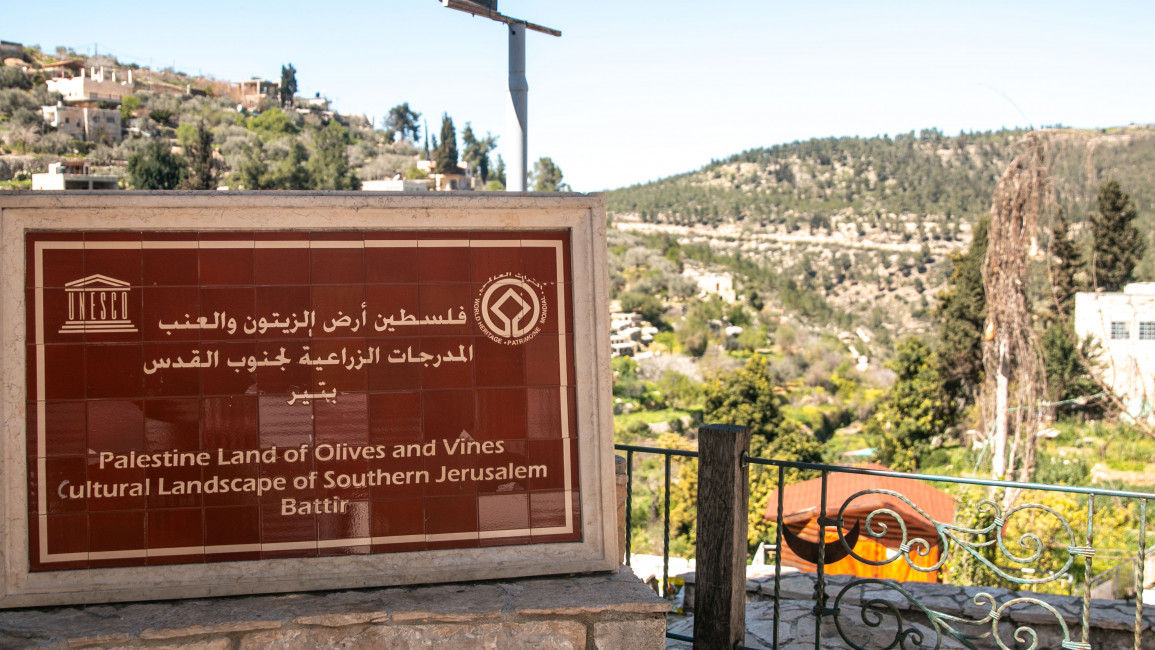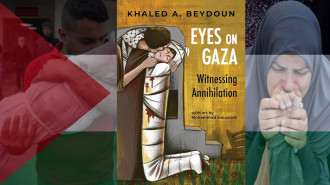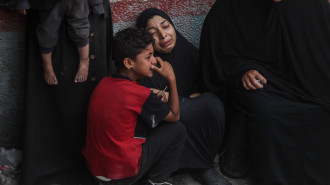
Life under siege in Bethlehem: How the birthplace of Jesus is now surrounded by Israeli settlements

Only one road still leads to Wadi Fukin.
The Palestinian village south of Bethlehem, in the occupied West Bank, is surrounded by Israeli settlements on all sides.
Their identical ochre houses overlook the wooded valley to which our path winds.
"Don't take any photos here, the settlers might attack us," whispered the only cab driver who agreed to take The New Arab there.
As we got closer, his nervousness grew. "Recently, they threw stones at a car of Palestinians who were driving here, and the children almost got killed."
After navigating through checkpoints and the oppressive walls of the settlements, we arrived safely in Wadi Fukin, a village of irreducible Palestinians: destroyed by the Israeli army in 1948 and then again depopulated during the 1967 war, its inhabitants have managed to rebuild it twice.
"We now live in an open-air prison," Ibrahim Manasra, farmer and local leader of the Arab Group for the Protection of Nature (APN), exclaimed by way of welcome.
The relief of arriving quickly is replaced by a feeling of suffocation. In Mansara's words, the 1,400 Palestinian inhabitants of Wadi Fukin are "totally walled in."
Life under siege in Wadi Fukin
To the south, the 60,000 mostly ultra-Orthodox Hasidic Jewish settlers of Betar Illit, a settlement founded in 1980.
To the north, the Green line that marks the border between Israel and the West Bank, and the Israeli town of Tzur Hadassah, built in 1956 on depopulated Palestinian villages — and which bears a striking resemblance to a settlement.
As a result of these encroachments, Wadi Fukin has lost 87% of its land since 1948.
"Israel is planning to build a new road for its settlers through the valley, leaving us with just 1,500 dunams [150 hectares]," Manasra insisted.
Settler attacks are a regular occurrence. "They assault children going to school, or even come to bathe in our springs, armed," he described.
As if that weren't enough, Betar Illit settlers dump their waste in Palestinian fields, and the Israeli army is omnipresent, conducting arrests and destroying houses. Ibrahim’s brother suffered that fate, his home reduced to rubble last November.
Solidarity in the face of isolation
Wadi Fukin is also suffering from the economic crisis ravaging the West Bank. After October 7, 200,000 Palestinians working in Israel found themselves without jobs when Benjamin Netanyahu's government froze their permits.
Since then, the West Bank's GDP has fallen by 22% and unemployment has reached a third of the working population.
"I'd say about half the workers in Wadi Fukin have lost their jobs [in Israel]. Those who have fields continue to feed themselves, but the others have nothing left," Ibrahim Manasra sighed.
The land is all that Wadi Fukin residents have left — along with solidarity.
"We stick together because nobody comes to help us. For example, I feed several of my neighbours with my fruit and vegetables," Manasra explained while unloading a hundred young guava seedlings from a truck to plant them in Wadi Fukin.
They come from APN, the organisation he works for, which has launched a campaign to reforest three million fruit trees in historical Palestine since 2000.
"For every tree uprooted by the Israelis, we decided to replant ten," he told The New Arab.
Bethlehem, a surrounded city
While Mahmoud Abbas’ Palestinian Authority is all but absent, residents of the Bethlehem area must fight on their own.
The birthplace of Jesus is now surrounded by 37 settlements of the “Gush Etzion” block, which aims to isolate it from Jerusalem and the rest of historical Palestine.
Even the town itself, beloved among Christian pilgrims visiting the church of Nativity, is surrounded by the Separation Wall and 170, 000 settlers, regularly attacked and dispossessed of its land.
The incense and serenity of its churches have not spared Bethlehem its share of tragedy.
It became a battleground during the two Intifadas, especially when 200 Palestinian resistance fighters and civilians retreated into the Church of Nativity in 2002 – which Israeli forces then besieged for 39 days, prompting criticism from a spokesperson of the Vatican who described the Israeli siege as an “indescribable act of barbarity.”
Bethlehem district’s strangulation is not coming to a close, as more than 1,000 new housing units are planned in the Efrat and Kedar settlements south of Bethlehem, almost 2,500 in Ma’ale Adumim, close to Jerusalem.
Its ecosystems will be recovered in concrete, walls and fences. A sad fate that some Palestinians, at least, have been trying to stop.
Battir, a menaced paradise
This is the case in Battir, a scenic village located three kilometres from Wadi Fukin and Bethlehem — and also stuck between the Green Line and Israeli settlements.
Its agricultural terraces, with cascades and orchards sprawl down a slope overlooking an old railway.
Battirs inhabitants won a series of fierce legal battles back in 2014 when they managed to secure their village a place on the UNESCO world heritage list — forcing the Israeli occupation to move the planned Segregation Wall away from the 2,000-year-old terraces and Roman baths.
“Since then, we’ve been trying to make Battir a model for sustainable tourism for all Palestine,” Sultan Shami, owner of a souvenir and handcrafts shop in the village’s old centre, proudly shared.
Together, the inhabitants created a unique ecomuseum — a hiking trail dotted with information about the region’s ecosystems and wildlife.
“We used to attract tourists from the whole world and had even more visitors than Bethlehem — the whole village profited from the industry, we opened guesthouses and sold local produce,” Shami remembered.
Shattered hopes
Alas, the war in Gaza has asphyxiated this economic boom. “We barely have a group of tourists per week, now,” he sighed.
Shami, who crafts his ceramic souvenirs depicting the cities of Palestine, stood in front of his empty atelier.
“I’m not able to do art since the genocide started,” he said gloomily.
The Israeli army has been conducting raids in this peaceful village, killing one man last February.
“They say he was armed with a knife, but we know him, and he wouldn’t hurt a fly — he was just going to have dinner with his friends,” Shami affirmed.
“One time, a group of eight visibly angry soldiers came to my shop, saw the flag of Palestine and graffitied over it, before punching a hole through the sign — I was very scared,” he remembered.
Another problem has arisen: a new settler is encroaching on Battir’s land. Muhammad Harbouq, the municipal engineer, drove The New Arab reporter to a hill overlooking the new outpost.
“Before October 7, all of us would drive there and confront him, so that the police would have to make him leave,” he explained.
Settlement expansion
“But since the war in Gaza, the police don’t come anymore, and he’ll shoot us… We’re afraid that he’ll grab land from our ecomuseum,” Harbouq said.
The outpost belongs to Har Gilo, an Israeli settlement that is slated for expansion – the new project would double its actual size by 560 new housing units, just 1.5 kilometres from the heritage site.
The municipal employee added that some antique agricultural terraces, which are protected under the UNESCO status, had been damaged by the Israeli army when they destroyed a road that the municipality had just paved, on the hill adjacent to the settler’s outpost.
“Most of our town’s territory is located in Area C, so even the municipality cannot build a road for its citizens there,” he bemoaned.
Battir and Wadi Fukin are just two villages among many on the frontlines of the creeping annexation of the occupied West Bank since its colonisation started in the 1970s.
Since October 7, the rhythm of land grabbing and violence has intensified, as more than 520 Palestinians have been killed, 5000 wounded and 9,000 imprisoned by the Israeli occupation forces, according to the UN.
Philippe Pernot is a French-German photojournalist living in Beirut. Covering anarchist, environmentalist, and queer social movements, he is now the Lebanon correspondent for Frankfurter Rundschau and an editor for various international media
Follow him on Twitter: @PhilippePernot7







 Follow the Middle East's top stories in English at The New Arab on Google News
Follow the Middle East's top stories in English at The New Arab on Google News


